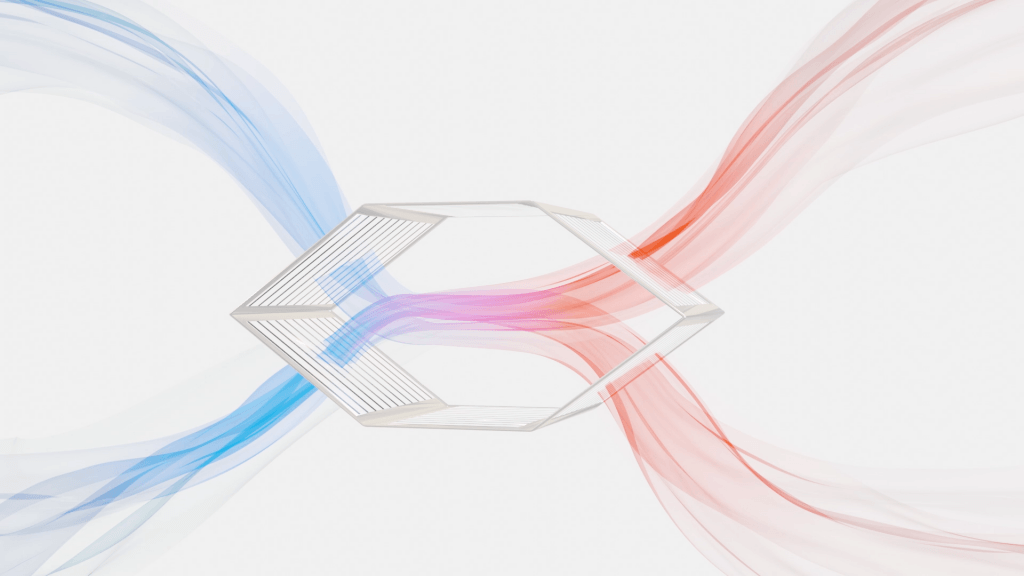Counterflow vs. crossflow heat exchanger
What types of heat exchangers are available and how do they differ?
Counterflow, crossflow or enthalpy – different applications call for different heat exchanger technologies. We’ll explain how the different types of heat exchangers work and what makes CORE heat exchangers so special.
How does a heat exchanger work?
Heat exchangers enable the transfer of energy between fresh and exhaust air. This conserves resources and improves the efficiency of buildings and ventilation systems. In doing so, heat exchangers employ simple laws of physics: The warm exhaust air transfers its thermal energy to the fresh incoming air. This retains the heat in the building, while exhaled CO2, pathogens and other undesirable gases are released with the exhaust air. Fresh incoming air and exhaust air flow past each other in separate channels to make this work. The larger the contact surface of the channels, the higher the efficiency of the heat exchange. The energy efficiency of a heat exchanger therefore depends on how the air flows are geometrically routed past one another.
How does a counterflow heat exchanger work?
Counterflow heat exchangers route the exhaust and fresh air past each other in separate channels, creating air flows in opposite directions. The temperatures of the air flows are thereby interchanged. In ideal circumstances, the original cold air has reached the temperature of the original warm air when it exits the heat exchanger, and vice versa. This requires that the incoming and outgoing volume flows are in perfect proportion to one another, meaning that the volume of air in both directions stays the same for a certain period of time. A parallel routing of the counterflows over a longer distance improves the result.
If the flow is also directed crosswise, heat exchangers can combine the physical and geometric advantages of parallel and crosswise air flow. This channel flow principle allows heat to be exchanged on all four sides, resulting in much higher efficiency than with conventional counterflow heat exchangers. This in turn allows the heat exchanger to be smaller in size. All counterflow heat exchangers from CORE use this geometry. They are more compact and are therefore also suitable for residential use.
How does a crossflow heat exchanger work?
Crossflow heat exchangers route the exhaust and supply air across one another. For example, the cold outside air flows from the upper left to the lower right and the warm, consumed exhaust air flows from the upper right to the lower left – each guided through several layers of slats in many small channels. In the process, the cold air is heated almost to room temperature, since this flow principle enables the temperatures in the channels to equalize almost as well as in counterflow heat exchangers.
Crossflow heat exchangers achieve high efficiencies, with heat transfer dependent on the surface area covered by the flow channels. This means: The larger the heat exchanger, the greater the heat recovery. This makes the principle especially suitable for large ventilation systems with high flow volumes and plenty of space – also because there are lower pressure losses during heat exchange. A cost factor that is not insignificant: The greater the pressure drop, the higher the power consumption of the fans in the ventilation system that circulate the air.
How do heat exchangers differ from enthalpy exchangers?
Enthalpy exchangers are heat exchangers that also transfer moisture. They humidify or dehumidify the room air. Too little humidity during the winter is not only unpleasant, but it can also even be harmful to your health. That is why heat exchangers with moisture recovery may also be needed in passive or low-energy houses. However, whether enthalpy is an option for you depends on many different factors. For instance, on the condition of the building itself. Or on the amount of moisture generated when the rooms are used, for example by hanging laundry, regular cooking or from plants.
In terms of channel routing and flow principle, enthalpy exchangers and heat exchangers are very similar. However, there are some differences between the two. In enthalpy exchangers, the hot and cold air flows are separated by a special membrane film rather than walls. This allows water vapor to pass through, but no other gases. For example, if warm air flows out, the moisture remains as vapor on the cooler surface of the membrane and migrates through the membrane in liquid form, similar to the osmotic principle in organic cells. On the side of the incoming, colder fresh air, the water evaporates again on the membrane surface, thus humidifying the room air. If the membrane is antibacterial, it prevents viruses, bacteria and mold spores from forming or reentering the building.
What makes heat and enthalpy exchangers from CORE special?
Long life, extensive certifications and the highest heat recovery efficiencies: Our heat and enthalpy exchangers impress with their exceptional performance values and versatile applications. In addition, patented CORE technology goes into all of our products: The specially developed polymer membrane in our enthalpy exchangers enables the efficient exchange of fluid and effectively prevents the formation of bacteria and mold. Last but not least, all of our products are thoroughly tested for leaks before delivery. For fresh air and a pleasant, healthy indoor environment.
Additional topics
Counterflow heat exchanger
Wide range of variants, superior performance: Discover our high-performance counterflow heat and enthalpy exchangers.
Crossflow heat exchanger
Proven technology, low maintenance: Discover our portfolio of crossflow heat and enthalpy exchangers.
Customized solutions
Individual support, custom-fit products: We are ready to customize our heat and enthalpy exchangers to meet the individual requirements of your ventilation system.



